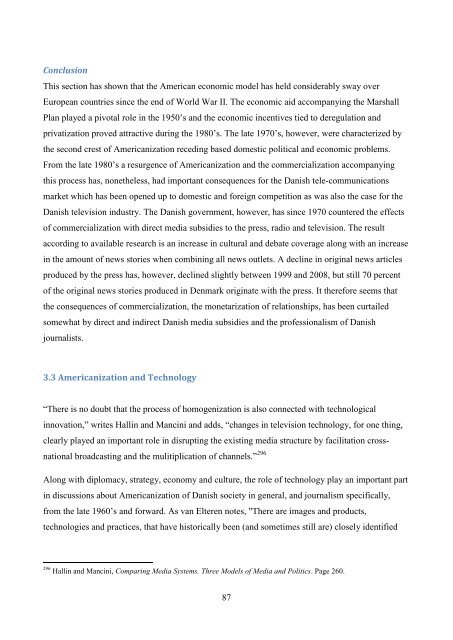The Jeremiad Over Journalism
The Jeremiad Over Journalism
The Jeremiad Over Journalism
Create successful ePaper yourself
Turn your PDF publications into a flip-book with our unique Google optimized e-Paper software.
Conclusion<br />
This section has shown that the American economic model has held considerably sway over<br />
European countries since the end of World War II. <strong>The</strong> economic aid accompanying the Marshall<br />
Plan played a pivotal role in the 1950‘s and the economic incentives tied to deregulation and<br />
privatization proved attractive during the 1980‘s. <strong>The</strong> late 1970‘s, however, were characterized by<br />
the second crest of Americanization receding based domestic political and economic problems.<br />
From the late 1980‘s a resurgence of Americanization and the commercialization accompanying<br />
this process has, nonetheless, had important consequences for the Danish tele-communications<br />
market which has been opened up to domestic and foreign competition as was also the case for the<br />
Danish television industry. <strong>The</strong> Danish government, however, has since 1970 countered the effects<br />
of commercialization with direct media subsidies to the press, radio and television. <strong>The</strong> result<br />
according to available research is an increase in cultural and debate coverage along with an increase<br />
in the amount of news stories when combining all news outlets. A decline in original news articles<br />
produced by the press has, however, declined slightly between 1999 and 2008, but still 70 percent<br />
of the original news stories produced in Denmark originate with the press. It therefore seems that<br />
the consequences of commercialization, the monetarization of relationships, has been curtailed<br />
somewhat by direct and indirect Danish media subsidies and the professionalism of Danish<br />
journalists.<br />
3.3 Americanization and Technology<br />
―<strong>The</strong>re is no doubt that the process of homogenization is also connected with technological<br />
innovation,‖ writes Hallin and Mancini and adds, ―changes in television technology, for one thing,<br />
clearly played an important role in disrupting the existing media structure by facilitation cross-<br />
national broadcasting and the mulitiplication of channels.‖ 296<br />
Along with diplomacy, strategy, economy and culture, the role of technology play an important part<br />
in discussions about Americanization of Danish society in general, and journalism specifically,<br />
from the late 1960‘s and forward. As van Elteren notes, "<strong>The</strong>re are images and products,<br />
technologies and practices, that have historically been (and sometimes still are) closely identified<br />
296 Hallin and Mancini, Comparing Media Systems. Three Models of Media and Politics. Page 260.<br />
87
















